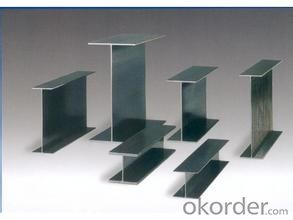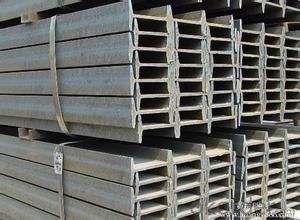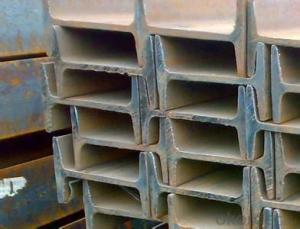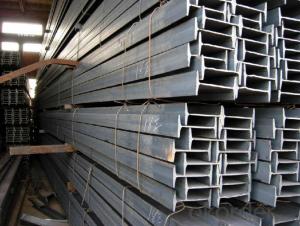High Quality BS Standard Structure Steel I Beam Details
- Loading Port:
- Tianjin
- Payment Terms:
- TT or LC
- Min Order Qty:
- 500 m.t.
- Supply Capability:
- 20000 m.t./month
OKorder Service Pledge
OKorder Financial Service
You Might Also Like
Product Description:
OKorder is offering High Quality BS Standard Structure Steel I Beam Detailsat great prices with worldwide shipping. Our supplier is a world-class manufacturer of steel, with our products utilized the world over. OKorder annually supplies products to European, North American and Asian markets. We provide quotations within 24 hours of receiving an inquiry and guarantee competitive prices.
Product Applications:
High Quality BS Standard Structure Steel I Beam Details are ideal for structural applications and are widely used in the construction of buildings and bridges, and the manufacturing, petrochemical, and transportation industries.
Product Advantages:
OKorder's High Quality BS Standard Structure Steel I Beam Details are durable, strong, and resist corrosion.
Main Product Features:
· Premium quality
· Prompt delivery & seaworthy packing (30 days after receiving deposit)
· Corrosion resistance
· Can be recycled and reused
· Mill test certification
· Professional Service
· Competitive pricing
Product Specifications:
Manufacture: Hot rolled
Grade: Q195 – 235
Certificates: ISO, SGS, BV, CIQ
Length: 6m – 12m, as per customer request
Packaging: Export packing, nude packing, bundled
Chinese Standard (H*W*T) | Weight (Kg/m) | 6m (pcs/ton) | Light I (H*W*T) | Weight (Kg/m) | 6m (pcs/ton) | Light II (H*W*T) | Weight (Kg/m) | 6M |
100*68*4.5 | 11.261 | 14.8 | 100*66*4.3 | 10.13 | 16.4 | 100*64*4 | 8.45 | 19.7 |
120*74*5.0 | 13.987 | 11.9 | 120*72*4.8 | 12.59 | 13.2 | 120*70*4.5 | 10.49 | 15.8 |
140*80*5.5 | 16.89 | 9.8 | 140*78*5.3 | 15.2 | 10.9 | 140*76*5 | 12.67 | 13.1 |
160*88*6 | 20.513 | 8.1 | 160*86*5.8 | 18.46 | 9 | 160*84*5.5 | 15.38 | 10.8 |
180*94*6.5 | 24.143 | 6.9 | 180*92*6.3 | 21.73 | 7.6 | 180*90*6 | 18.11 | 9.2 |
200*100*7 | 27.929 | 5.9 | 200*98*6.8 | 25.14 | 6.6 | 200*96*6.5 | 20.95 | 7.9 |
220*110*7.5 | 33.07 | 5 | 220*108*7.3 | 29.76 | 5.6 | 220*106*7 | 24.8 | 6.7 |
250*116*8 | 38.105 | 4.3 | 250*114*7.8 | 34.29 | 4.8 | 250*112*7.5 | 28.58 | 5.8 |
280*122*8.5 | 43.492 | 3.8 | 280*120*8.2 | 39.14 | 4.2 | 280*120*8 | 36.97 | 4.5 |
300*126*9 | 48.084 | 3.4 | 300*124*9.2 | 43.28 | 3.8 | 300*124*8.5 | 40.87 | 4 |
320*130*9.5 | 52.717 | 3.1 | 320*127*9.2 | 48.5 | 3.4 | |||
360*136*10 | 60.037 | 2.7 | 360*132*9.5 | 55.23 | 3 |
FAQ:
Q1: Why buy Materials & Equipment from OKorder.com?
A1: All products offered byOKorder.com are carefully selected from China's most reliable manufacturing enterprises. Through its ISO certifications, OKorder.com adheres to the highest standards and a commitment to supply chain safety and customer satisfaction.
Q2: How do we guarantee the quality of our products?
A2: We have established an advanced quality management system which conducts strict quality tests at every step, from raw materials to the final product. At the same time, we provide extensive follow-up service assurances as required.
Q3: How soon can we receive the product after purchase?
A3: Within three days of placing an order, we will begin production. The specific shipping date is dependent upon international and government factors, but is typically 7 to 10 workdays.
Q4: What makes stainless steel stainless?
A4: Stainless steel must contain at least 10.5 % chromium. It is this element that reacts with the oxygen in the air to form a complex chrome-oxide surface layer that is invisible but strong enough to prevent further oxygen from "staining" (rusting) the surface. Higher levels of chromium and the addition of other alloying elements such as nickel and molybdenum enhance this surface layer and improve the corrosion resistance of the stainless material.
Q5: Can stainless steel rust?
A5: Stainless does not "rust" as you think of regular steel rusting with a red oxide on the surface that flakes off. If you see red rust it is probably due to some iron particles that have contaminated the surface of the stainless steel and it is these iron particles that are rusting. Look at the source of the rusting and see if you can remove it from the surface.
Images:


- Q:How do you calculate the compression capacity of a steel I-beam?
- The compression capacity of a steel I-beam can be calculated by considering various factors such as the cross-sectional area, moment of inertia, and the yield strength of the material. 1. Determine the cross-sectional area of the I-beam: The cross-sectional area can be calculated by measuring the width and height of the beam and multiplying them together. For example, if the width is 6 inches and the height is 10 inches, the cross-sectional area would be 60 square inches. 2. Calculate the moment of inertia: The moment of inertia is a measure of the beam's resistance to bending. It can be calculated using the formula: I = (b * h^3) / 12, where b is the width and h is the height of the beam. For example, if the width is 6 inches and the height is 10 inches, the moment of inertia would be 500 inch^4. 3. Determine the yield strength of the steel: The yield strength is the maximum stress that the steel can withstand before it starts to deform permanently. It can be obtained from the material specifications or testing. For example, if the yield strength of the steel is 50,000 pounds per square inch (psi). 4. Calculate the compression capacity: The compression capacity can be calculated using the formula: P = Fy * A, where P is the compression capacity, Fy is the yield strength, and A is the cross-sectional area. For example, if the yield strength is 50,000 psi and the cross-sectional area is 60 square inches, the compression capacity would be 3,000,000 pounds. It is important to note that the calculation of compression capacity assumes ideal conditions and does not take into account factors such as buckling or lateral torsional buckling, which can affect the actual capacity of the beam. Therefore, it is recommended to consult structural engineering guidelines or consult a professional engineer for a comprehensive analysis and design of steel I-beams.
- Q:Can steel I-beams be used in sports stadium construction?
- Indeed, sports stadium construction can make use of steel I-beams. The construction industry often relies on steel I-beams for their remarkable strength, durability, and versatility. These beams are specifically designed to bear heavy loads and offer structural support, which makes them exceedingly suitable for extensive undertakings like sports stadium projects. Moreover, the fabrication and installation of steel I-beams are relatively straightforward, resulting in efficient construction processes. Their capacity to span long distances without requiring additional support columns further grants flexibility in stadium design and layout. Consequently, steel I-beams are widely favored in sports stadium construction, owing to their exceptional structural properties and aptness for managing the distinctive demands of such endeavors.
- Q:Can steel I-beams be used for retaining walls?
- Steel I-beams can indeed be used for retaining walls. Their structural strength and durability make them an excellent choice for supporting and holding back soil or other materials. However, it is important to consider factors such as the height and load requirements of the retaining wall, as well as any local building codes or regulations that may dictate the specific materials and construction methods to be used. Consulting with a structural engineer or construction professional is recommended to ensure the appropriate design and installation of the retaining wall.
- Q:How do steel I-beams perform in high-temperature environments?
- Steel I-beams perform well in high-temperature environments due to their inherent strength and heat resistance. Steel has a high melting point, which makes it suitable for withstanding elevated temperatures. In a high-temperature environment, steel I-beams retain most of their structural integrity and load-bearing capacity. However, it is important to note that steel's strength decreases as the temperature rises. At temperatures exceeding 500°C (932°F), the steel may start to lose its load-bearing capacity. Additionally, prolonged exposure to high heat can cause steel to deform or warp, which might compromise its structural integrity. Therefore, in extreme high-temperature environments, additional fire protection measures such as fire-resistant coatings or insulation may be necessary to maintain the I-beams' performance. Overall, steel I-beams are a reliable choice for use in high-temperature environments, but caution should be exercised in extreme conditions to ensure their long-term effectiveness.
- Q:Can steel I-beams be used for parking garages?
- Yes, steel I-beams can be used for parking garages. Steel I-beams are often preferred in the construction of parking garages due to their high strength and durability. They provide excellent load-bearing capabilities, allowing for the construction of large and multilevel parking structures. Additionally, steel I-beams offer flexibility in design, allowing for efficient use of space and ease of construction.
- Q:Can steel I-beams be used in historical building preservation projects?
- Yes, steel I-beams can be used in historical building preservation projects. They offer structural support and can help strengthen the building's framework without compromising its historical integrity. However, it is important to consider the specific requirements and guidelines of the preservation project to ensure that the use of steel I-beams aligns with the goals and objectives of preserving the historical building.
- Q:How do steel I-beams perform in terms of energy efficiency?
- Steel I-beams are known for their strength and durability, but when it comes to energy efficiency, they may not be the most ideal choice. Steel is a good conductor of heat, which means that it can easily transfer heat from the inside to the outside of a building or vice versa. This can result in significant energy loss when it comes to heating or cooling a space. Additionally, steel production is energy-intensive, requiring large amounts of energy to extract and refine iron ore and coal to produce steel. This process contributes to greenhouse gas emissions and is not considered environmentally friendly. However, it is important to note that energy efficiency is not solely determined by the choice of I-beams, but rather the overall design and construction of a building. Proper insulation, efficient HVAC systems, and energy-efficient windows can help mitigate the impact of steel I-beams on energy efficiency. Furthermore, steel I-beams offer advantages in terms of structural integrity and design flexibility, allowing for larger open spaces and longer spans. These benefits can lead to more efficient use of materials and potentially reduced construction costs. In conclusion, while steel I-beams may not be the most energy-efficient choice, their overall impact on a building's energy efficiency can be mitigated through other design and construction measures. It is important to consider the entire building envelope and energy systems when evaluating the energy efficiency of a structure.
- Q:Can Steel I-Beams be used for power plants?
- Yes, steel I-beams can be used for power plants. Steel I-beams are commonly used in construction due to their structural strength and load-bearing capacity. In power plants, where heavy machinery and equipment are involved, steel I-beams can provide the necessary support and stability. These beams can be used for various applications in power plants, including supporting turbines, generators, boilers, and other critical components. Additionally, steel I-beams have excellent resistance to heat and can withstand high temperatures, making them suitable for power plants where thermal energy is involved.
- Q:What is the typical span length for steel I-beams?
- The typical span length for steel I-beams can vary depending on several factors such as the load they need to support, the type of construction, and the specific design requirements. However, in general, steel I-beams can have span lengths ranging from 10 feet to over 100 feet. The span length is determined by considering the maximum allowable deflection, the weight and distribution of the load, and the properties of the steel beam itself. Structural engineers and architects typically calculate the appropriate span length for steel I-beams based on these factors to ensure structural stability and safety.
- Q:How are steel I-beams used in residential construction?
- Steel I-beams are commonly utilized in residential construction due to their robustness and durability. They primarily serve as load-bearing structures to uphold the structure's weight. I-beams are frequently employed in constructing the principal framework, including the foundation, walls, and floors. A key advantage of employing steel I-beams is their ability to span large distances without necessitating additional support columns. This facilitates more spacious floor layouts and offers greater design flexibility. In residential construction, I-beams are commonly used to fashion vast open areas, such as living rooms or kitchens, where walls can be eliminated or reduced. Furthermore, steel I-beams are vital in supporting the weight of upper levels or floors in multi-story residences. They furnish the essential strength to bear the load and avert sagging or structural collapse. Additionally, I-beams are utilized to uphold hefty loads such as the weight of a roof or large windows, ensuring overall stability and structural integrity. Moreover, steel I-beams possess resistance against fire, decay, and pests, rendering them a dependable choice for residential construction. They also boast a commendable strength-to-weight ratio, signifying their ability to support substantial loads while being relatively lightweight. This facilitates easier and more cost-effective installation. In conclusion, steel I-beams play a pivotal role in residential construction by providing structural support, enabling open floor plans, and ensuring the safety and stability of the edifice. Their strength, durability, and versatility make them an ideal selection for contemporary homes.
1. Manufacturer Overview |
|
|---|---|
| Location | |
| Year Established | |
| Annual Output Value | |
| Main Markets | |
| Company Certifications | |
2. Manufacturer Certificates |
|
|---|---|
| a) Certification Name | |
| Range | |
| Reference | |
| Validity Period | |
3. Manufacturer Capability |
|
|---|---|
| a)Trade Capacity | |
| Nearest Port | |
| Export Percentage | |
| No.of Employees in Trade Department | |
| Language Spoken: | |
| b)Factory Information | |
| Factory Size: | |
| No. of Production Lines | |
| Contract Manufacturing | |
| Product Price Range | |
Send your message to us
High Quality BS Standard Structure Steel I Beam Details
- Loading Port:
- Tianjin
- Payment Terms:
- TT or LC
- Min Order Qty:
- 500 m.t.
- Supply Capability:
- 20000 m.t./month
OKorder Service Pledge
OKorder Financial Service
Similar products
New products
Hot products
Hot Searches
Related keywords































